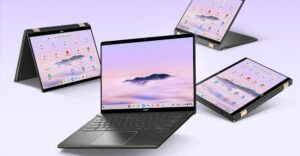I stopped working for Forrester in 2002 and went out on my own as an independent analyst. At that time, Intel’s valuation and power significantly eclipsed AMD and Nvidia. Intel had a strong corporate brand, and Pentium was so popular people wrote songs about it, and Qualcomm wasn’t even on Intel’s radar.
Twenty-two years later, Intel is hurt and bleeding. AMD is hosting an event at the Moscone Center, where Intel used to hold its huge IDF events. Nvidia is the highest-valued company in the group, and Qualcomm reportedly recently explored a move to buy Intel.
What the hell happened? Intel took its eye off the ball and repeated many of the same mistakes that IBM made in the 1980s.
Let’s examine how Intel’s trajectory has changed over the past two decades, tracing the key missteps and missed opportunities that allowed AMD, Nvidia, and Qualcomm to surpass it. We’ll close with my Product of the Week, a new Lenovo laptop that uses Intel’s new Lunar Lake Core Ultra 7 processors.
IBM to Intel
When I worked at IBM, I wrote a report largely because I was extremely frustrated by how the company, which had been massively dominant when I joined it, had lost that dominance.
At IBM, I worked in finance, internal audit, and marketing. I was one of the people who tried to point out that IBM was about to lose its dominance, only to be told by the VP to whom I reported that “IBM sells the equivalent of air. Customers have no choice but to buy from us.” Clearly, this turned out to be untrue, as customers eventually fled the company in huge numbers, almost putting IBM out of business.
In a panic, IBM’s Board of Directors fired then-CEO John Akers and replaced him with Louis Gerstner, a marketing expert who knew nothing about tech but rightly realized that IBM first had to fix its image and restore sales volume, or the company would fail.
This was similar to what happened at Apple in the late 90s with Steve Jobs. Apple’s products weren’t competitive, but the base was still loyal, so Jobs initially moved to fix Apple’s image of having crap products and then eventually fixed those products. Still, he never would have been able to do the latter had he not first fixed Apple’s image and slowed its sales decline.
IBM’s recovery under Gerstner was nearly magical, with CFO Jeremy York, who also played a role in Apple’s turnaround, doing much of the heavy lifting behind the scenes. Gerstner built a marketing organization that arguably surpassed even Nabisco’s, his previous company.
However, the recovery slowed when York left IBM, and it virtually stopped when Sam Palmisano decided marketing wasn’t that important, which collapsed Gerstner’s marketing effort. Had Palmisano not done that, I believe IBM would be much larger and more powerful today.
In the 1990s, Intel was a marketing powerhouse under the marketing leadership of Dennis Carter and the brilliant leadership of Andy Grove. Intel reached a level of dominance in its segment that, while not as great as IBM’s had been, was still far ahead of its competitors.
However, once Dennis Carter and Andy Grove retired, Intel started to take its massive leadership for granted. Marketing execution and funding declined dramatically, and Intel began burning through subsequent CEOs, each with a different vision. The most damage was done by Brian Krzanich, who effectively put the company’s primary product on life support as he tried to chase Qualcomm’s smartphone market.
Intel started to fall behind AMD, which remained focused and had more consistent leadership, particularly over the last decade under IBM-trained Lisa Su. Meanwhile, Qualcomm, buoyed by its smartphone success, aimed to enter the PC market, and Nvidia quietly bet on AI, which seemed more like a 2040 event than near-term technology. The loss of Justin Rattner, Intel’s near-legendary CTO, was also problematic and likely helped keep Intel’s leadership in the dark about AI’s potential.
Pushed by Apple, Intel failed dramatically in its effort to take out Qualcomm, which made it look vulnerable and made the world aware that Intel’s execution wasn’t where it should have been, and marketing was a shadow of what it once was. It was no longer strategic, so much as a cost center that seemed to lack any institutional value.
Thus, Intel had no defense against the erosion of its brand or the appearance of market leadership.
AI Hits
The rise of AI last year was 20 years in the making. Only Nvidia and IBM invested significantly in this technology, although even IBM didn’t think it would hit as soon as it did, with every subsequent CEO underfunding the effort against its potential.
Nvidia equipped OpenAI with its technology, and ChatGPT was adopted by Microsoft in a move similar to what it did with Spyglass — Microsoft’s initial successful effort to take out Netscape Navigator — and adopted ChatGPT under the brand Copilot.
Nvidia rode the wave because it helped create it, and AMD, already used to fast-following Intel, came up quickly from behind. Companies like Microsoft and Google now treat AMD’s AI solutions as peers to Nvidia’s offerings. Given that Nvidia’s offerings are so popular that it cannot keep up with demand, AMD is seeing a substantial uplift in its visibility and revenue.
At the same time, Qualcomm, working with Microsoft, created an AI platform for PCs that was performant and provided huge battery life benefits. Again, AMD quickly pivoted and brought to market a Qualcomm-competitive effort that performs well against Qualcomm’s offering — partially because it doesn’t need an emulator for x86.
Intel not only didn’t see AI coming (to be fair, no one did), but when Microsoft asked for an NPU, Intel pushed back instead of stepping up. It did an incredible job of bringing in its Lunar Lake technology that had been two years out, but it is a premium part, and Intel won’t have a performant NPU in the mainstream for at least another year.
Now, the desktop implementations of AI are still very limited and not widely used. No workstations, desktop PCs, or gaming PCs (laptops or desktops) have NPUs yet. This situation should give Intel the time it needs, but the lack of Intel marketing doesn’t allow it to pitch what it has properly, so it’s bleeding market share.
Even though Intel still leads in market share, it appears to be where AMD used to be seemingly overnight, and it’s chasing AMD, Nvidia, and Qualcomm rather than appearing as the market share leader it is.
If Intel still had a marketing team funded and supported as it was under Dennis Carter, it could do what IBM did under Louis Gerstner and Apple did under Steve Jobs by slowing its market erosion until it came up with a performant solution. As good as Lunar Lake is, it isn’t broad enough to carry this load alone, and without powerful marketing, it will likely underperform its potential anyway.
Wrapping Up: The Problem With Under-Resourcing Marketing
That conversation I had at IBM has haunted me for decades because it is so frequently repeated. Tech firms tend not to listen to customers. I get it. As Steve Jobs once said, customers often don’t know what they want. But that means companies need to do what Jobs did and position what they offer against needs customers don’t yet realize they have. This ability to manipulate demand is the purview of marketing.
Taking the iPhone as an example, it was based on the LG Prada phone that failed largely because people just didn’t like virtual keyboards. They preferred physical keyboards that existed from Microsoft, Palm, and Research In Motion (Blackberry).
With little resistance, Apple convinced the market that its virtual keyboard design was superior by emphasizing entertainment features. Rather than defending their positions, the leading competitors followed Apple’s lead, effectively ending the era of keyboard smartphones.
The recurring mistake is under-resourcing marketing and taking customers for granted. It’s interesting to note that only IBM recognized this because of Louis Gerstner and effectively addressed the issue with IBM’s recovery, but even they forgot this lesson with the subsequent CEO.
Thus, we are seeing a trend similar to that seen with IBM vs. Sun, Netscape vs. Microsoft, Palm/Nokia/Microsoft/Blackberry vs. Apple, and now Intel vs. AMD/Nvidia/Qualcomm, as leadership again shifts because the once dominant vendor didn’t adequately defend its image of dominance and success with marketing.

The Lenovo Yoga Slim 7i Aura Edition Laptop
The Yoga Slim 7i Aura Edition is an impressive laptop that uses the new Lunar Lake Intel Core Ultra 7 processor.
It is a premium notebook with a reasonable entry price of under $1,300. Fully loaded, it is under $1,500, but I found the entry configuration to be good enough for me, making it a value. It features a massive touchpad, an excellent keyboard (as you’d expect from Lenovo), and a premium feel.

Yoga Slim 7i Aura Edition Laptop (Image Credit: Lenovo)
I thought Lunar Lake laptops would hit in the $2,000-plus price range, so this one stands out as an appealing bargain (I like bargains).
The Aura Edition branding means it comes with premium support capabilities and will pair better with your Google or Apple smartphone. There are some additional features I haven’t had a chance to try yet. One is that it can take the refresh rate from 30 to 120 Hz based on need, which not only provides gaming-like frame rates when you need them but energy savings when you don’t.
Back to the keyboard. I’m writing on this laptop now, and it is surprisingly quiet and comfortable. It has the feel of a mechanical keyboard but not the annoying clicking sound they often have. This isn’t a gaming laptop — it has Intel Arc graphics — but I love this keyboard and will be sad to see this laptop go back to Lenovo in a week or so.
The display is a very nice 15-inch 2.8K, one of the finest non-OLED displays I’ve seen so far. OLED is better, but it pulls a ton of power, making this display a decent tradeoff.
The port-outs are decent, with Thunderbolt and USB-C ports and a legacy USB-A port. On the side next to the power switch, there is a “camera off” switch (the camera supports Windows Hello and is nice but not anything special).
The sound from the laptop is impressive, and it supports Dolby Atmos. I think this is the best-sounding laptop that I have tested this year. Oh, and it has a headphone jack, which means if you forget your expensive wireless headphones on a trip, you can buy cheap, wired earbuds and still watch your movies. (By the way, did you know you can’t download Netflix movies on a PC anymore?)
The Lenovo Yoga Slim 7i Aura Edition laptop is an impressive product that showcases the hard work both Lenovo and Intel have done to create it, making it my Product of the Week.





















































